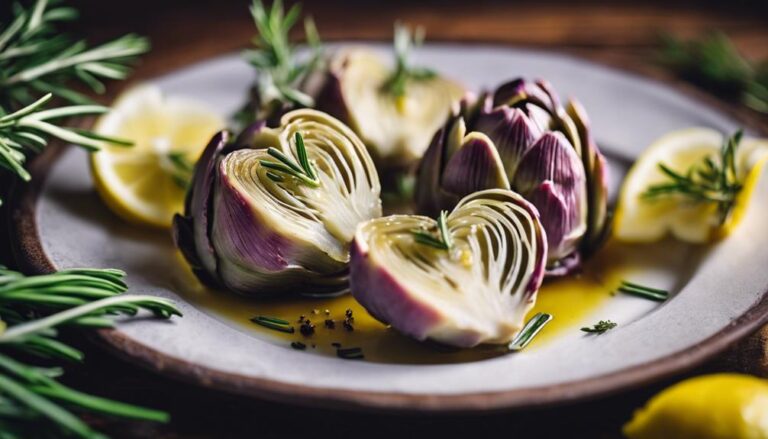Sous Vide Coconut Yogurt With Fermented Honey
Imagine this: velvety yogurt meets the zing of honey, creating a flavor explosion in your mouth. This blend takes your yogurt game to epic heights, giving you a glimpse into the exciting world of gourmet yogurt-making. The creamy texture paired with the rich tanginess will leave you wanting more. Get ready to impress your taste buds and guests with this culinary masterpiece that's as delicious as it is unique. Trust me, this journey into yogurt paradise is totally worth it!
What You Will Learn Here
- Creamy Sous Vide Coconut Yogurt made with precision and consistency
- Fermented Honey adds a sweet tang and depth of flavor
- Culinary art combining fermentation and sous vide cooking techniques
- Unique gourmet treat with luxurious texture and taste
- Perfect balance of flavors and textures in this creative yogurt recipe
Cultural Origins

So, you're ready to venture into the cultural origins of yogurt-making techniques, traditional fermentation methods, and the historical significance behind these delicious practices.
Get set to explore how different cultures have perfected the art of yogurt-making, using unique methods passed down through generations.
From the intriguing history to the mouthwatering traditions, this is where your culinary adventure begins!
Yogurt-Making Techniques
Explore the diverse cultural origins behind various yogurt-making techniques. Different regions have unique flavor profiles and fermentation techniques that give yogurt its distinct taste.
From the creamy Greek yogurt to the tangy Indian dahi, each culture brings its own twist to this fermented dairy product.
Beyond taste, yogurt-making also offers probiotic benefits and health advantages. The live cultures present in yogurt aid digestion and promote gut health, making it a popular choice for those seeking a delicious way to boost their well-being.
Traditional Fermentation Methods
Traditional fermentation methods used in yogurt-making reflect a rich tapestry of cultural origins, each infusing their unique techniques and flavors into this beloved dairy product. When comparing traditional vs. modern fermentation, you'll find that while modern methods often prioritize consistency and efficiency, traditional approaches hold onto age-old practices that add depth and character to the final product.
These methods not only contribute to the delicious taste of yogurt but also offer numerous health benefits. Fermentation helps break down lactose, making yogurt easier to digest for those with lactose intolerance. Additionally, the live cultures formed during fermentation are like a probiotic party in your gut, promoting good digestive health.
Historical Significance
Travel back in time through the origins of yogurt-making methods, and uncover the rich cultural tapestry woven into the historical significance of this beloved dairy product. Yogurt has a fascinating history with influences from various cultures, showcasing the evolution of techniques and its cultural significance. Check out the table below to see how yogurt has been shaped by historical influence and modern adaptation:
| Historical Influence | Modern Adaptation | Evolution of Techniques | Cultural Significance |
|---|---|---|---|
| Ancient Mesopotamia | Dairy-free options | Traditional fermentation | Health benefits |
| Indian Ayurveda | Flavor innovations | Industrial production | Culinary traditions |
| Mediterranean diets | Probiotic strains | Sous Vide technology | Rituals and celebrations |
From ancient Mesopotamia to today's dairy-free options, yogurt continues to evolve while holding onto its cultural roots.
Key Yogurt-Making Ingredients

To make delicious yogurt, make sure you have the right key ingredients on hand. Here are some essentials for your yogurt-making adventure:
- Milk or Dairy Alternatives: Whether you prefer classic cow's milk or want to explore dairy alternatives like almond or coconut milk, the base liquid is essential for yogurt-making.
- Yogurt Culture: This magical ingredient kickstarts the fermentation process, transforming milk into creamy yogurt.
- Probiotic Benefits: Yogurt is packed with probiotics, the good bacteria that promote a healthy gut. Homemade yogurt allows you to control the probiotic content.
- Sweeteners: From honey to sugar, adding a touch of sweetness can elevate the flavor of your yogurt. You can also experiment with natural sweeteners like maple syrup or agave nectar.
- Flavorings: Get creative with flavorings like vanilla extract, fruit purees, or even a hint of citrus zest to customize your yogurt to suit your taste buds.
Yogurt-Making Techniques
So, you're ready to become a yogurt-making pro, huh?
Let's talk techniques – we've got the Coconut Milk Yogurt Method, the Coconut Milk Yogurt Blend, and the Creamy Coconut Yogurt Blend on our list.
Get your mixing bowls ready because we're about to whip up some creamy goodness!
Coconut Milk Yogurt Method
If aiming for a richer consistency in your coconut milk yogurt, consider incorporating a longer incubation period to enhance the fermentation process. Here are some tips to perfect your coconut milk yogurt:
- Use probiotic capsules for fermentation.
- Keep the yogurt undisturbed during fermentation.
- Experiment with different incubation times for varying textures.
- Strain the yogurt for a thicker consistency.
- Add sweeteners or fruits after the fermentation process for flavor variety.
These tricks will help you master the art of making delicious coconut milk yogurt at home. So, go ahead, play with flavors, and enjoy the creamy goodness your taste buds deserve!
Coconut Milk Yogurt Blend
For a creamy and flavorful twist on traditional yogurt-making techniques, consider blending coconut milk with other dairy-free alternatives. Coconut milk adds a tropical touch to your yogurt, elevating its taste and providing a unique spin on a classic favorite.
Here are some reasons why this blend can take your yogurt game to the next level:
- Flavor profiles: Coconut milk brings a rich, creamy flavor that pairs well with various fruits and toppings.
- Fermentation process: The probiotics in coconut milk support gut health during the fermentation process.
- Nutritional benefits: Enjoy the added vitamins, minerals, and healthy fats present in coconut milk.
- Taste preferences: Experiment with different blends to find the perfect balance that suits your taste buds.
- Creamy texture: Achieve a velvety smooth texture that will make your coconut yogurt irresistible.
Creamy Coconut Yogurt Blend
Blend coconut milk with other dairy-free alternatives to create a creamy and decadent yogurt that will elevate your homemade yogurt game. When perfecting your yogurt blend, consider exploring different flavor profiles and tapping into the magic of the fermentation process.
To enhance your yogurt-making experience, explore the health benefits of these dairy-free creations and carefully select high-quality ingredients sourced sustainably.
Here are some tips to help you craft the creamiest coconut yogurt blend:
- Mix It Up: Combine coconut milk with almond or cashew milk for a richer texture.
- Sweeten Naturally: Add a touch of maple syrup or agave for a hint of sweetness.
- Add a Twist: Incorporate vanilla extract or a sprinkle of cinnamon for unique flavors.
- Get Tangy: Experiment with longer fermentation times for a tangier yogurt.
- Top It Off: Finish with fresh fruit or crunchy granola for a delightful crunch.
Yogurt Texture Enhancements
So, you want your yogurt to be as smooth as a jazz saxophonist's solo, right? Well, first up, let's talk about the creaminess factor. It's like the holy grail of yogurt texture, making each spoonful a silky dream.
Next, consistency is key; you don't want your yogurt to be too runny or too thick – finding that perfect spooning texture is an art form.
And last but not least, that silkiness in your mouth when you savor each bite? That's the ultimate goal, turning a simple snack into a luxurious treat.
Creaminess Factor Importance
Enhancing the creaminess factor of your yogurt can elevate the overall texture and mouthfeel of the final product. When it comes to yogurt, the creaminess is like the cherry on top – it's what takes your spoonful from average to exceptional.
The importance of this factor lies in achieving that perfect balance between silkiness and thickness. Picture this: a spoon gliding effortlessly through your yogurt, leaving behind a trail of luxurious creaminess. That's the dream, right?
Consistency for Spooning
To achieve the ideal consistency for spooning your yogurt, focus on texture enhancements that guarantee a smooth and indulgent experience with every bite. When aiming for that perfect spoonful, think about creating a balance between creamy and firm textures. You want your yogurt to be thick enough to hold its shape on the spoon, yet velvety enough to glide effortlessly in your mouth.
Experiment with different flavor pairings to elevate the spooning consistency – perhaps a sprinkle of granola for that extra crunch or a drizzle of honey for a touch of sweetness. By finding the right combination of textures and flavors, you'll turn your yogurt into a delightful treat that will have you reaching for seconds (or thirds!).
Silkiness in Mouth
Achieve a luxurious silkiness in your yogurt by incorporating texture enhancements that guarantee a velvety smooth mouthfeel with each spoonful.
When it comes to enhancing the silkiness in your yogurt, think of it as creating a sublime sensory experience. By focusing on the texture, you elevate the flavor profiles to new heights.
Imagine a yogurt so smooth and creamy that it glides effortlessly across your palate, enriching your taste buds with every bite. This level of silkiness isn't just about taste; it's about creating a full-bodied experience that leaves you craving more.
Final Thoughts
Consider reflecting on your culinary journey with this delightful Sous Vide Coconut Yogurt With Fermented Honey recipe. As you finish indulging in the creamy texture and sweet tang of this dish, take a moment for reflections. Perhaps you discovered a newfound appreciation for the art of fermentation or the magic of sous vide cooking. Maybe you marveled at how a few simple ingredients can transform into a gourmet treat right in your kitchen.
Looking ahead, think about future applications of your newfound skills. Could this coconut yogurt be the star of your next breakfast bowl, topped with fresh fruits and crunchy granola? Or maybe you'll experiment with different flavors for the fermented honey, adding a zesty kick with some ginger or a floral note with lavender. The possibilities are as endless as your creativity in the kitchen. So go forth, armed with your sous vide precision and fermentation prowess, and whip up more culinary delights that will surely impress your taste buds and guests alike.
Frequently Asked Questions
Can I Use Regular Honey Instead of Fermented Honey?
Yes, you can use regular honey instead of fermented honey. The fermentation process gives a unique flavor to the honey, but regular honey will work fine in most recipes. Just adjust the taste as needed.
What Are Common Troubleshooting Issues With Coconut Yogurt?
If you face texture issues or flavor problems with coconut yogurt, it might be due to temperature fluctuations. Separation concerns could arise from improper fermentation or inadequate mixing. Adjusting these factors can help improve your yogurt.
How Long Does It Take to Ferment Honey?
Fermenting honey usually takes a couple of weeks. The process reveals unique flavors and health benefits. Try adding fruits or spices for exciting fermented honey recipes. Enjoy the transformation and taste of homemade fermented honey.
Is Sous Vide Yogurt-Making Faster Than Traditional Methods?
When making yogurt, sous vide is faster than traditional methods. It offers precise temperature control for consistent results. Taste comparison shows sous vide yogurt can have a smoother texture and potential for customization of flavors.
Can I Add Fruit to the Yogurt During the Sous Vide Process?
Yes, you can add fruit to the yogurt during the sous vide process. Experiment with different flavor combinations to enhance the taste. Adding fruit not only infuses the yogurt but also creates a delicious and invigorating treat.
Conclusion
So there you have it, folks! Making sous vide coconut yogurt with fermented honey may sound fancy, but it's actually a fun and delicious kitchen experiment.
Remember, a little patience and the right ingredients can go a long way in creating a creamy, tangy treat that will have your taste buds dancing.
So grab your apron and get ready to impress your friends with your newfound yogurt-making skills. Happy cooking!











